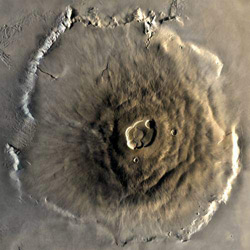I post a lot of pictures here from Hubble, Spitzer, and other massively-funded large observatories. But it doesn’t take a huge, multi-billion-dollar project to create amazing astronomical images. Proof in point: Emil Kraaikamp is one of the more gifted astrophotographers I’ve seen. He has a 25 cm (10”) telescope that he uses to create truly jaw-dropping views of the sky.
 Want proof? Check this image out: it’s an animation he made of Mars, using observations he made in early December and showing the planet’s rotation over the course of
Want proof? Check this image out: it’s an animation he made of Mars, using observations he made in early December and showing the planet’s rotation over the course of more than two hours about 45 minutes (a day on Mars is a half hour longer than Earth’s). You can clearly see both the south and north polar ice caps together with several dark surface features on the planet, which in itself is lovely and very cool.
But what blew me away is something you may not notice immediately in the picture. Take a look on the left side of the animation. See those three aligned blue spots, with the one blue spot to the lower right? Those are called orographic clouds, formed when moist air is lifted up over an obstacle; the air cools and the moisture condenses, forming clouds. What kind of obstacle on the Martian surface could do that?
 Volcanoes. Yes, volcanoes: in the animation, you can actually see clouds that have formed as the Martian atmosphere moves up the banks of the enormous volcanoes on the Tharsis shield, a massive uplift feature on Mars. The fourth cloud to the lower right is actually marking the spot of Olympus Mons, the largest volcano in the solar system. The image inset here is from NASA, showing Olympus Mons up close; but you don’t need to go to Mars to see it.
Volcanoes. Yes, volcanoes: in the animation, you can actually see clouds that have formed as the Martian atmosphere moves up the banks of the enormous volcanoes on the Tharsis shield, a massive uplift feature on Mars. The fourth cloud to the lower right is actually marking the spot of Olympus Mons, the largest volcano in the solar system. The image inset here is from NASA, showing Olympus Mons up close; but you don’t need to go to Mars to see it.
After all, it can be captured with a ten inch telescope.
Holy – and for once I mean this literally, folks – Haleakala.
On his page, Emil Kraaikamp showed how he took three images using red, green, and blue filters to create the stills that were then used for the animation:
I love this, because it shows how using filters tells you a lot about what you’re seeing. Note that in the red Mars is fairly smooth, with some dark spots. The red dust covers the planet, so it smooths out features (though the ice caps are obvious). In the green you’re just starting to see a hint of clouds, and then in the blue the clouds pop right out.
Combine them, and you have Mars. Another world, seen through what most people would consider a small telescope here on Earth.
You absolutely must peruse his other planet images; the animations of Jupiter are fantastic, and the detail he was able to capture on Venus – normally a featureless white blur – is nothing short of spectacular!
I’ll add that his setup is quite sophisticated, and he spent many hours processing these images, so it’s not like you can buy an off-the-shelf ‘scope and expect to do this on your first night. But it does show what someone dedicated to the art and science of astronomy can do when they set their mind and heart to it. Amazing.
Credits: Images from Emil Kraaikamp used with permission. Olympus Mons image: NASA.